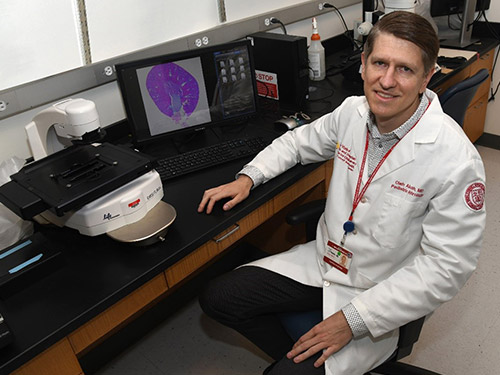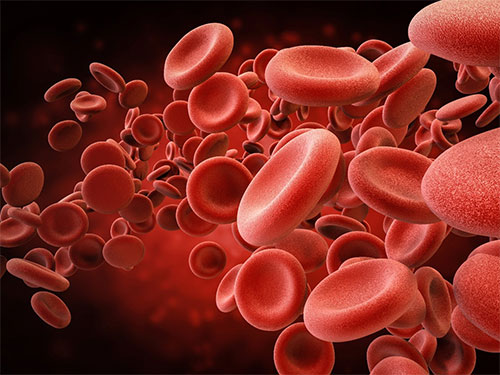A new study led by a NewYork-Presbyterian/
While anemia — as measured by hemoglobin levels — has long been suspected as a possible factor in inhibiting growth in children with CKD, earlier studies have been inconclusive in demonstrating the association. The new findings, which are based on a prospective cohort study with more than 15 years of follow up observation, could have implications for how anemia is managed in children with nonglomerular CKD.

Oleh Akchurin, MD, PhD
“It is known from other anemias, such as nutritional iron deficiency in children without kidney disease, that they don’t grow well, and they have problems with physical development. However, in the context of chronic kidney disease, this mechanism has not been looked at,” explains Oleh Akchurin, MD, PhD, a pediatric nephrologist at NewYork-Presbyterian/
Growth impairment is a common complication for children with CKD and is more severe among children with the nonglomerular form of the disease. Recombinant growth hormone therapy is available as a treatment for growth impairment but requires daily injections for several years, making it an unattractive option for many patients. For children who do receive the therapy, the results have been uneven. “The problem of poor growth in children with CKD is far from being sorted out,” Dr. Akchurin says.
Dr. Akchurin and colleagues set out to quantify the relationship between hemoglobin and statural growth in children with nonglomerular CKD using data from the Chronic Kidney Disease in Children (CKiD) cohort study, which includes records from children and adolescents across 50 sites in the United States and Canada. The researchers looked specifically at age- and sex- -specific hemoglobin z scores and height z scores, which are calculated using the US Centers for Disease Control and Prevention reference data. They thencompared hemoglobin z scores at earlier study visits with height z-scores at later visits across pairs of annual visits to assess their relationship over time.
The analysis included 510 children with nonglomerular CKD who were still growing and were not receiving recombinant growth hormone therapy:
- At baseline, the average age was 9 years-old and two-thirds of the children were male
- The baseline height z score was -0.5, indicating that the children were shorter than average for their age and sex (average z score is 0.0)
- The average hemoglobin level was 12.9 g/dL, which showed that many of the children in the cohort had levels that would not be classified as anemia under current guidelines.
- Approximately 25% of the children were receiving iron therapy and 5% were receiving treatment with an erythropoiesis-stimulating agent at study entry.
As Dr. Akchurin and colleagues examined the change in hemoglobin and height across annual visit pairs they found that there was an association between a decline in hemoglobin level and poor growth that started with a hemoglobin z score below -1.0. The association was independent of kidney function, sex, and age.
“We demonstrated that there is a connection between hemoglobin and change in height, which previously wasn’t clear… It starts, for many patients, before they reach the cutoff that our current guidelines recommend as the definition of anemia.” — Dr. Oleh Akchurin
The link between the hemoglobin z score and lower height z score was seen even among children who did not meet the current guideline threshold for anemia.

Anemia and statural growth impairment are both common in children with nonglomerular CKD.
“We demonstrated that there is a connection between hemoglobin and change in height, which previously wasn’t clear. The study also indicates when the connection starts. It starts, for many patients, before they reach the cutoff that our current guidelines recommend as the definition of anemia,” says Dr. Akchurin. “It’s possible that even before they become anemic in the sense of current definitions, hemoglobin decline may already be affecting their growth.”
When the researchers stratified their findings by age, they found that the association was statistically significant at ages 8- 14 years, indicating its importance in the pre- and early puberty years.
The findings established an association, not causation, so they should be treated carefully, Dr. Akchurin says. However, they suggest that an evaluation of anemia should not be overlooked in patients with even mild CKD.
Whether the association should trigger more aggressive treatment of anemia in children with nonglomerular CKD is a question that deserves further study, Dr. Akchurin says. Current treatment for renal anemia is iron therapy first, followed by treatment with an erythropoiesis-stimulating agent. However, Akchurin points out that when iron treatment was evaluated in mice with CKD, it did not improve their skeletal growth. “It’s not as simple as saying, let’s intensify treatment,” he says. “We do need to treat it better but right now we don’t have the tools to do it.”
Dr. Akchurin says he hopes that the findings will stimulate other researchers to examine innovative approaches to the treatment of anemia. In the meantime, he and colleagues at NewYork-Presbyterian/
“We demonstrated that children with CKD who have higher hemoglobin are able to grow better, independent of their kidney function. Before, we didn’t know that. So now we look at how this can be achieved,” Dr. Akchurin says.




